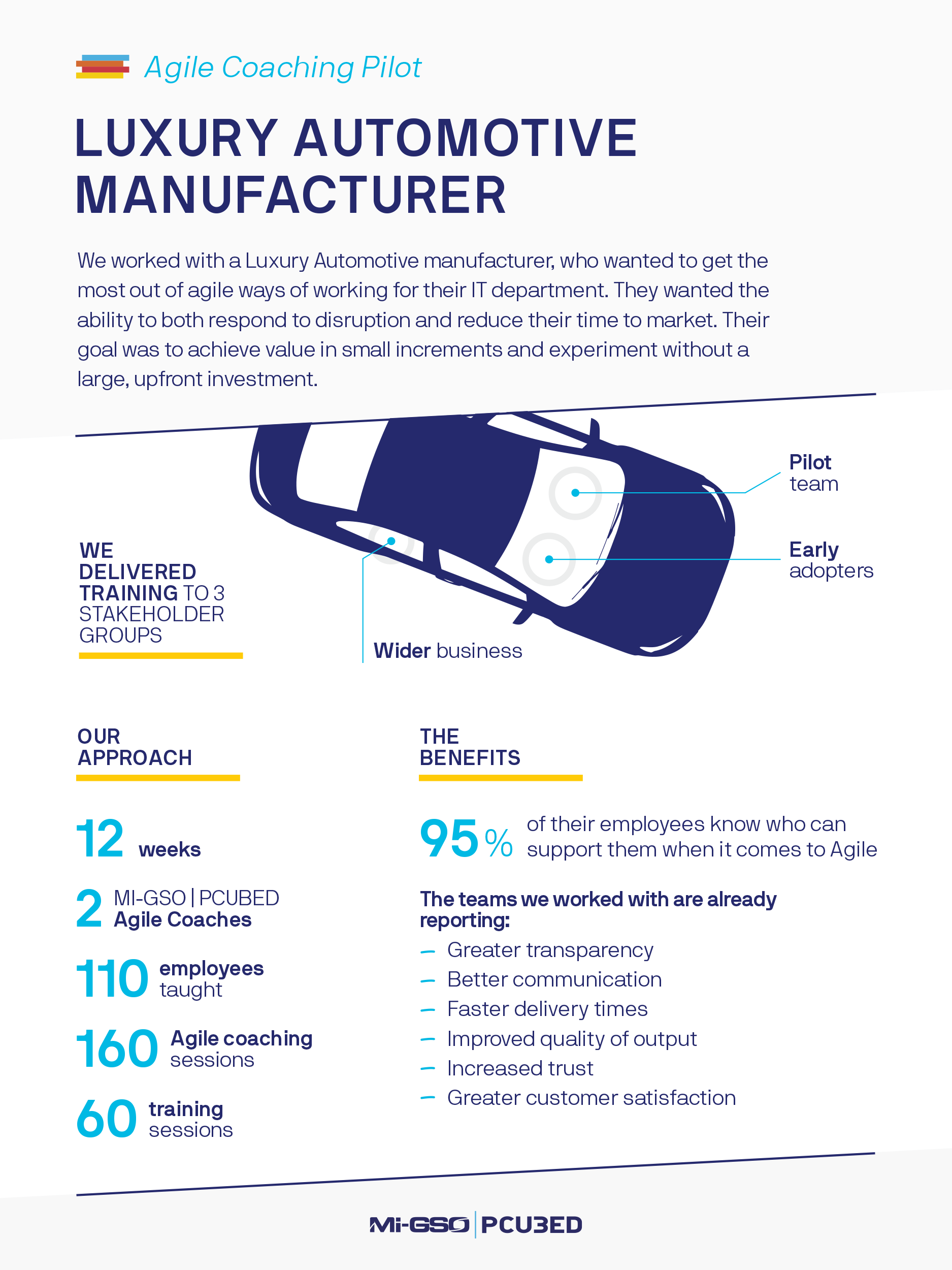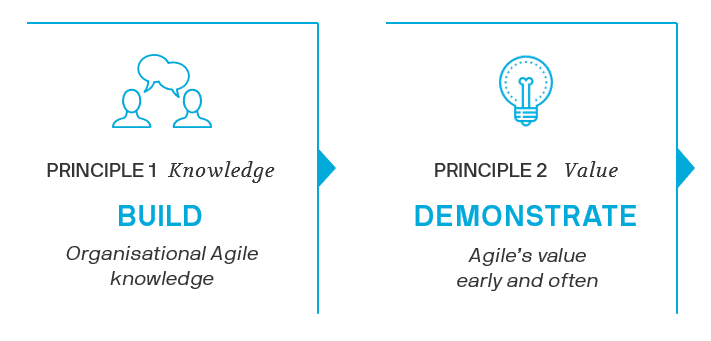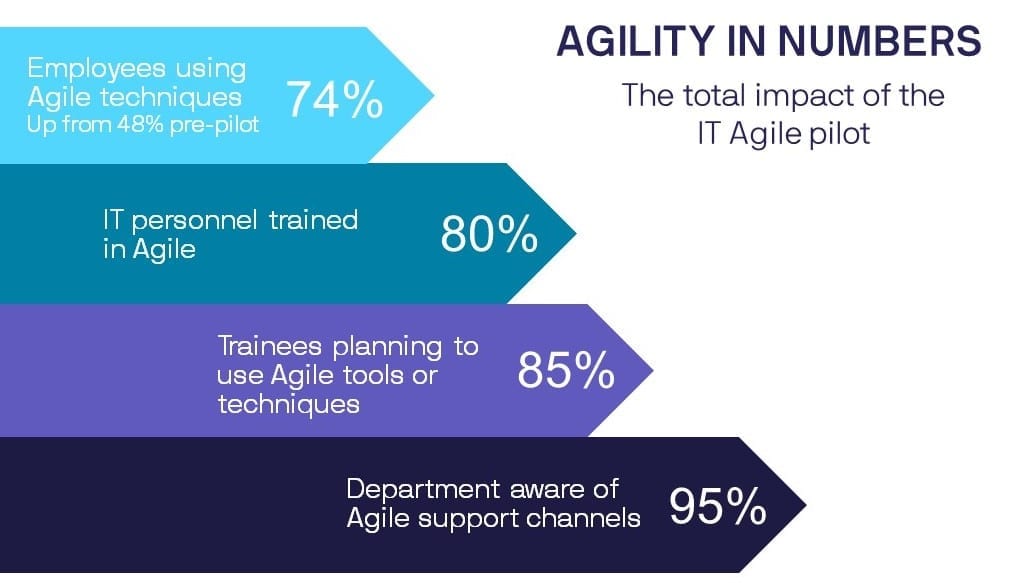Our website is not supported on this browser
The browser you are using (Internet Explorer) cannot display our content.
Please come back on a more recent browser to have the best experience possible

Our client, a luxury automaker, wanted to get the most out of agile ways of working for their IT department. The team desired the ability to both respond to disruption and reduce their time to market. Their goal was to achieve value in small increments and unlock experimentation without a large, upfront investment.

The client’s chief information officer (CIO) turned to MIGSO-PCUBED to lead an Agile Transformation pilot across their IT department.
Our client wanted to build empowered, flexible teams that could provide incremental value to their customers quickly. The executive leadership already knew that enhanced agility was the way forward. They had even identified organisational agility as a key strategic enabler to the future success of their company.
So, organisational willingness wasn’t the issue. The challenge was implementation.
As business agility consultants, we work with a lot of companies who want to become more agile. Many aren’t sure of how to take the first step. They don’t know how to transform their existing ways of working or to make the change last after it’s happened.
It’s no secret that change initiatives require a lot of effort, and are ripe with challenges. However the intended benefits are still worthwhile pursuing, in spite of any uphill battles.
Our client experienced these challenges first-hand. Over a period of four years, the client focused on building agile teams across their organisation. They had modest success in making individual teams more agile. But, when it came to their entire organisation, they were stuck.
Agile training for team members can be a powerful tool for individual groups. However, it’s not enough to establish an entirely agile organization. Agility at scale requires properly addressing the wider environment and landscape of business agility in addition to any team-level training.
The MIGSO-PCUBED team proposed to set up the pilot project to run according to agile principles. This provided the client with an adaptive plan that could flexibly respond to the clients’ training and coaching needs.
This plan was underpinned by two main principles: to build the organisation’s Agile knowledge step-by-step and to demonstrate value early and often.

To increase confidence and prove that the agile transformation was here to stay, the team committed to showing tangible progress throughout the pilot. This meant delivering value in every increment, like up-skilling the Pilot Project teams in agile techniques that they could use right away.
The team also built in a mechanism for feedback and continuous improvement with project retrospectives. These were touch points that gave the client the chance to discuss challenges or get advice from our agile consultants.
To address the wider environment and landscape of business agility, the team focused on getting key stakeholders up to speed. The MIGSO-PCUBED team broke up key stakeholders into three distinct groups: pilot project teams, early adopters, and the wider business team.
In each sprint, the team delivered a suite of training, coaching, mentoring, and workshops; across all three groups in parallel. The approach was targeted to maximise the effectiveness, reach, and longevity of the pilot. The team offered crash courses in everything: methodologies like SCRUM, our own Business Agility model, Agile coaching, and Emotional Intelligence.
For the Pilot Project Teams, the goal was to find employees who would be reasonably open to Agile ways of working. These people were a neutral point between Agile evangelists and skeptics, gauging how the implementation could work for the entire company.
I thought the session was good and can see the advantage of bringing this framework into our Project and Product teams.
For the early adopters group, these people were chosen as advocates for agility in the business. They were power users who made up a cross-section of the business, with a range of awareness and experience.
I think it very easily covered the high-level methodologies and liked that you made reference to how these could be applied. To me it was made very clear that this is a set of tools to be used, not a hard and fast rule that must be followed to the tee.
Our coaches and managers were within this group. The managers of the IT department (including the CIO) volunteered to be guided on leadership behaviors and what to expect from Agile ways of working. Our consultants then worked closely with them to ensure that they could serve as the experts to their teams.
As for the coaches, they were nominated from countless people all over the IT department. They became champions and trained in various tools and processes. Some went on to work with the pilot teams, which was MP’s larger goal.
As the CIO wanted to implement agile approaches across the organization after the pilot, our team made sure that the coaches would be comfortable with upholding agility long after the initial engagement.
Finally, the Wider Business team stakeholder group included influential figures in the business, like executives, so that the pilot could be seen as making an early impact. Our team made sure that senior management was informed and could be involved, keeping their business running smoothly.
60
12
7
110
160
2
At first, innovation efforts can be frustrating for those who don’t grasp the big picture yet. To ease those feelings and build momentum, it’s incredibly important to communicate early wins. That will help you build a solid argument for change management.
Although the Agile pilot was sponsored by the CIO and supported by other executives, it was critical to get the entire management team comfortable with agility.
With a wide range of methodologies available, Agile is a broad topic that means different things to different people. Therefore, the team highlighted nine internal case studies reflecting the client’s early successes with agile. This helped reinforce our client’s confidence in their decision to embrace agility, while showing them the extent of the possibilities along with their internal gains.
Based on our prior transformation and change project successes, like our work in embedding Lean Project Champions at Sellafield Ltd, we knew one of the most critical success factors was empowering the workforce. They could only affect change if they were taught the right skills.
I am really starting to see benefits in day to day work.
For our work with this luxury automotive manufacturer, we didn’t just train the workforce in delivering agile to their projects. We taught them how to coach their colleagues, too. We knew that this project would come and go. However, if we embedded a self-sustaining network of agile experts, then our client could realise value indefinitely.

This project was a big hit with our client. Today, 95% of their surveyed employees now know who can support them when it comes to Agile. Immediately following this pilot, our client commissioned the second phase of work to become a more agile organisation.
The teams we worked with are already reporting:
This article was written by James Martin-Young
Loved what you just read?
Let's stay in touch.
No spam, only great things to read in our newsletter.
We combine our expertise with a fine knowledge of the industry to deliver high-value project management services.
MIGSO-PCUBED is part of the ALTEN group.
Find us around the world
Australia – Canada – France – Germany – Italy – Mexico – The Netherlands – Portugal – Romania – South East Asia – Spain – Switzerland – United Kingdom – United States
© 2024 MIGSO-PCUBED. All rights reserved | Legal information | Privacy Policy | Cookie Settings | Intranet
Perfect jobs also result from great environments : the team, its culture and energy.
So tell us more about you : who you are, your project, your ambitions,
and let’s find your next step together.
Dear candidates, please note that you will only be contacted via email from the following domain: migso-pcubed.com. Please remain vigilant and ensure that you interact exclusively with our official websites. The MIGSO-PCUBED Team
Choose your language
Our website is not supported on this browser
The browser you are using (Internet Explorer) cannot display our content.
Please come back on a more recent browser to have the best experience possible
